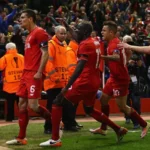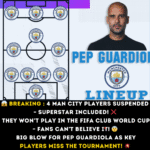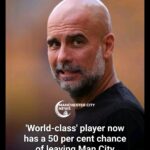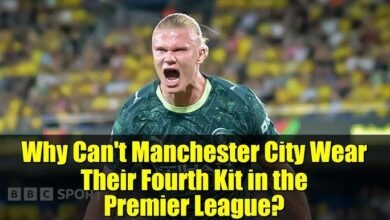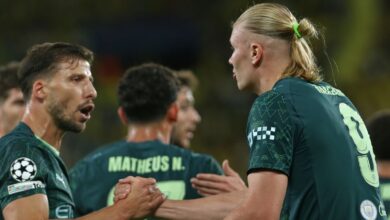Mateo Kovacic’s Injury Struggles: A Comprehensive Analysis of Manchester City’s Midfield Concerns and World Cup Uncertainty

Manchester City’s 2025-26 campaign has been marked by unexpected challenges, not least of which has been the prolonged absence of experienced midfielder Mateo Kovacic. The Croatian international, who has become an integral part of Pep Guardiola’s midfield rotation since his arrival at the Etihad Stadium, finds himself facing one of the most difficult periods of his professional career. What began as a summer procedure to address an Achilles problem has evolved into a complicated medical situation requiring additional surgical intervention, raising serious questions about both his immediate future with the Premier League champions and his availability for one of football’s most prestigious tournaments.
The 31-year-old’s injury saga represents more than just a setback for an individual player; it highlights the precarious nature of elite football, where even the most carefully managed rehabilitation programs can encounter unforeseen complications. As Manchester City navigate a season with ambitions across multiple competitions, the extended absence of a player of Kovacic’s quality and experience has forced significant adjustments to Guardiola’s tactical plans and squad rotation strategies.
The Timeline of Troubles: From Summer Surgery to Further Setbacks
The story of Kovacic’s current predicament begins in the summer months, during what should have been a period of rest and preparation for the new campaign. Instead, the midfielder underwent surgery on his Achilles tendon, a procedure that football medical professionals approached with the expectation of a straightforward recovery process. Achilles injuries, while serious, are relatively well-understood in sports medicine, and the initial prognosis suggested that Kovacic would be available for selection as the season progressed into autumn.
However, the reality has proven far more challenging than anyone anticipated. Kovacic missed virtually the entire opening phase of Manchester City’s season, watching from the sidelines as his teammates competed in the Premier League, Champions League, and domestic cup competitions. The midfielder’s absence was felt keenly in a squad that prides itself on depth and quality across all positions, particularly given the technical sophistication and tactical intelligence that Kovacic brings to Guardiola’s system.
The first glimmer of positive news arrived at the end of September when Kovacic was deemed fit enough to rejoin the matchday squad for Manchester City’s Premier League encounter with Burnley. His return to the group represented what many hoped would be the beginning of his reintegration into the team, a gradual process of rebuilding match fitness and sharpness through carefully managed minutes on the pitch.
True to form, Guardiola exercised caution in managing Kovacic’s comeback. The midfielder was introduced from the substitutes’ bench in the closing stages of victories over Everton and Villarreal, brief cameos designed to ease him back into competitive action without placing excessive strain on his recovering body. These appearances, though limited in duration, seemed to suggest that the worst was behind the player and that he would soon be available for more substantial contributions.
Unfortunately, this optimism proved premature. Kovacic began experiencing pain once again, a concerning development that indicated the initial surgery had not fully resolved the underlying issue. Medical examinations revealed the presence of calcification in the ankle area, a complication that would require further surgical intervention to address properly. The news represented a devastating blow to a player who had worked diligently through his rehabilitation program, only to find himself back at square one.
Pep Guardiola’s Assessment: Reading Between the Lines
When questioned about Kovacic’s condition during a press conference last week, Pep Guardiola provided an update that, while measured in tone, clearly indicated the seriousness of the situation. “He will be out for a while,” the Manchester City manager stated, his words carefully chosen to convey both the reality of the setback and the uncertainty surrounding the recovery timeline.
Guardiola elaborated on the specific nature of the problem, explaining that Kovacic “still has a problem with the ankle, a little calcification still there.” The use of the word “little” might suggest a minor issue, but in the context of elite football, even small complications can have significant ramifications for a player’s ability to perform at the highest level. The presence of calcification—an abnormal buildup of calcium deposits in soft tissue—can cause pain, restrict movement, and interfere with the normal functioning of joints and tendons.
The manager’s concluding remark—”We’ll wait on him for the last part of the season”—hints at a timeline extending well into 2026, effectively writing off a substantial portion of the campaign for the midfielder. This phrasing is particularly telling given Guardiola’s typical reluctance to commit to specific timeframes for injured players, preferring instead to assess each case on a day-by-day basis as recovery progresses.
What Guardiola has been careful not to specify is exactly when the “last part of the season” begins. In football terms, this could refer to the critical spring months when titles are decided and European competitions reach their knockout stages. The vagueness serves multiple purposes: it manages external expectations, avoids placing unnecessary pressure on the player, and maintains flexibility should the recovery process encounter further complications or, conversely, proceed more smoothly than anticipated.
For Manchester City, the loss of Kovacic for such an extended period represents a significant disruption to squad planning. The club’s success under Guardiola has been built partly on the ability to rotate key players without significant drop-offs in performance quality. Kovacic’s technical ability, tactical understanding, and versatility have made him an valuable asset in this system, capable of operating in various midfield roles depending on the opposition and match situation.
Croatia’s Concerns: World Cup Dreams Hanging in the Balance
While Manchester City’s concerns are primarily focused on the club season, there is an even more significant competition on the horizon that adds an extra layer of urgency and emotion to Kovacic’s situation. The 2026 FIFA World Cup, scheduled to be held across venues in the United States, Canada, and Mexico, represents what could be Kovacic’s final opportunity to compete on football’s grandest stage.
Zlatko Dalic, the manager who guided Croatia to a remarkable runner-up finish at the 2018 World Cup and a third-place finish in 2022, has voiced his concerns about whether his experienced midfielder will be available for selection. “I hope Kovacic won’t miss the World Cup,” Dalic stated, his words carrying the weight of genuine worry about losing one of his most important players for such a crucial tournament.
The Croatian coach’s assessment of the situation reveals a deeper understanding of the challenges Kovacic faces. “He has similar problems to those he had four or five months ago,” Dalic observed, highlighting the recurring nature of the issue and the frustration that comes with seeing a player struggle with the same area of concern despite initial treatment. This repetition of symptoms is particularly troubling from a medical perspective, as it suggests either that the original problem was not fully resolved or that new complications have developed in the same anatomical region.
Despite the obvious concerns, Dalic maintains a publicly optimistic stance: “We believe he’ll be with us at the World Cup.” This expression of faith serves multiple purposes—it shows support for the player during a difficult time, maintains positive messaging around the national team’s preparations, and avoids creating a sense of panic that could affect squad morale or complicate Croatia’s planning for the tournament.
The Croatian manager has set an ambitious target for Kovacic’s return: “I’d like him to be back in March.” This timeline is significant because it would allow the midfielder to participate in Croatia’s pre-World Cup preparation matches, crucial opportunities for match fitness, tactical integration, and building chemistry with teammates. The March international window typically features important qualification matches or, for teams already qualified, strategic friendlies designed to fine-tune systems and assess form.
What makes Dalic’s comments particularly poignant is his acknowledgment of the psychological dimension of Kovacic’s struggle. “It must be tough for him,” the manager noted with evident empathy. “The injury and the surgery are taking a psychological toll on him.” This recognition of the mental health aspects of injury recovery is increasingly common in modern football, as coaches and medical staff better understand that physical healing represents only one component of a successful return to action.
The psychological challenges facing an injured player are multifaceted and profound. There is the frustration of watching teammates compete while being unable to contribute, the anxiety about whether full fitness will ever return, the fear of reinjury upon returning to action, and the broader existential questions about career longevity and future opportunities. For a player of Kovacic’s age—31 years old—these concerns are heightened by the awareness that time is not on his side, that each setback potentially represents not just a temporary absence but a permanent diminishment of his career trajectory.
Dalic’s closing sentiment—”I hope Kovacic gets through it all”—encapsulates both the uncertainty of the situation and the genuine concern felt by those who work closely with the player. The phrase “gets through it all” suggests an understanding that Kovacic faces not just one challenge but a series of interconnected obstacles: the physical recovery from surgery, the psychological burden of repeated setbacks, the pressure of competing at the highest level, and the looming deadline of World Cup selection.
The Worst-Case Scenario: Missing Football’s Greatest Stage
For Mateo Kovacic, missing the 2026 World Cup would represent the worst possible outcome of this injury saga. The tournament carries enormous significance for any international player, but for someone who has already experienced the highs of World Cup competition with Croatia—including runs to the final in 2018 and the semi-finals in 2022—the prospect of being absent from what could be his final opportunity to compete at this level is undoubtedly haunting.
The World Cup occupies a unique place in football’s hierarchy of achievement. While club competitions like the Champions League command enormous prestige and financial rewards, the World Cup remains the pinnacle of the sport, the tournament that transcends club boundaries and brings together the best players from around the globe in a celebration of national pride and sporting excellence. For players, the chance to represent their country at a World Cup is often described as the highlight of their careers, regardless of what they might have achieved at club level.
Croatia, despite being a nation of just over four million people, has established itself as one of the most consistently impressive teams on the international stage over the past decade. Much of this success has been built on the strength of their midfield, a technically gifted group of players capable of controlling matches through precise passing, intelligent positioning, and tactical discipline. Kovacic has been a central figure in this midfield unit, his ability to progress the ball from defense to attack and his composure under pressure making him an indispensable part of Croatia’s system.
The prospect of competing without Kovacic would force Dalic into significant tactical adjustments. While Croatia possesses other talented midfielders, the specific combination of attributes that Kovacic brings—his close control, his ability to evade pressure, his tactical intelligence, and his experience in high-stakes matches—would be extremely difficult to replicate. The manager would need to reconfigure his tactical approach, potentially sacrificing some of the team’s characteristic control and possession dominance in favor of other qualities.
From Kovacic’s personal perspective, missing the World Cup would represent an enormous disappointment and a source of lasting regret. Athletes at the elite level are acutely aware of the finite nature of their careers, the narrow window of opportunity during which their bodies allow them to compete at peak performance. At 31, Kovacic is approaching the latter stages of his career, and while modern sports science has extended the productive years of many players, the harsh reality is that opportunities like the World Cup are precious and limited.
The Realistic Expectation: A February Return to Action
Despite the worst-case scenarios and the legitimate concerns about World Cup availability, the prevailing expectation among those close to the situation is that Kovacic will make his return to action in February 2026. This timeline, while representing a significant absence from Manchester City’s campaign, offers hope that the midfielder can salvage something meaningful from the season and build toward international duty.
A February return would mean that Kovacic misses approximately half of Manchester City’s season, including crucial autumn and winter months when the Premier League title race typically begins to take shape and European competitions reach their knockout phases. However, it would also position him to contribute during the critical final stretch of the campaign, the period when every match carries enormous weight and squad depth can prove decisive in determining which teams emerge victorious across multiple competitions.
The timeline also provides a pathway, albeit a tight one, toward World Cup readiness. If Kovacic can successfully return to action in February and avoid further setbacks, he would have several months to rebuild match fitness, regain his sharpness, and demonstrate to Dalic that he merits inclusion in Croatia’s World Cup squad. February through May represents roughly 12-15 weeks of potential playing time with Manchester City, enough to accumulate meaningful minutes and prove his fitness.
The possibility of representing Croatia in their March fixtures, as mentioned in the original reporting, would be particularly valuable from a national team perspective. International matches during the March window would provide Dalic with an opportunity to assess Kovacic’s condition firsthand, to see how he integrates with the squad after his extended absence, and to make informed decisions about his role in World Cup plans. These matches would serve as important stepping stones, allowing Kovacic to build confidence and chemistry with teammates in a slightly lower-pressure environment than the World Cup itself.
However, the path from surgery to full fitness is rarely straightforward, and Manchester City and Croatia must approach Kovacic’s rehabilitation with appropriate caution. The fact that his initial return from summer surgery resulted in renewed pain and the need for additional procedures serves as a stark reminder that rushing recovery can prove counterproductive. The medical staff overseeing his care will need to balance the desire to have him available for important matches against the imperative of ensuring that he is genuinely ready to withstand the physical demands of elite competition.
The rehabilitation process for this type of injury typically involves multiple phases, each with specific goals and markers of progress. Initial stages focus on reducing inflammation, managing pain, and maintaining cardiovascular fitness through low-impact activities. Subsequent phases introduce more sport-specific movements, gradually building load tolerance and functional strength. Final stages involve full training participation, tactical work, and match conditioning. Throughout this process, medical staff monitor the player’s response, looking for any signs of recurring symptoms that might indicate insufficient healing or the need for modifications to the rehabilitation protocol.
The Broader Context: Manchester City’s Midfield Puzzle
Kovacic’s absence occurs against the backdrop of another significant midfield injury for Manchester City, compounding Guardiola’s selection challenges and forcing the manager to rely more heavily on available players. Rodri, the Spanish midfielder who has been arguably City’s most important player in recent seasons, is also dealing with injury problems that have limited his availability.
The simultaneous absence of both Kovacic and Rodri has thrust additional responsibility onto other members of City’s midfield corps, most notably Nico Gonzalez. The Spanish midfielder has responded admirably to this increased responsibility, demonstrating the kind of tactical intelligence and technical quality that Guardiola demands from his players. His goal in Manchester City’s impressive 3-0 victory over Liverpool—one of the season’s most significant results—exemplifies the growing influence he has assumed within the team structure.
Gonzalez’s emergence as a more prominent figure in City’s midfield represents a silver lining to the injury crisis. One of the characteristics of Guardiola’s coaching philosophy is his ability to develop players, to identify latent qualities and nurture them through careful coaching and strategic deployment. The increased playing time afforded to Gonzalez by the absence of Kovacic and Rodri has accelerated his development, forcing him to adapt to more demanding situations and exposing him to the kind of high-pressure matches that forge elite players.
Nevertheless, while Gonzalez’s progress is encouraging, Manchester City remain a team built on depth and quality across all positions. The club’s success under Guardiola has been predicated on the ability to rotate key players without significant drops in performance level, to respond to different tactical challenges with appropriate personnel adjustments, and to manage the physical demands of competing across multiple competitions throughout a long season. Kovacic’s technical ability, tactical understanding, and experience make him an asset that cannot easily be replaced, even by talented younger players like Gonzalez.
The midfield conundrum facing Guardiola reflects broader challenges in modern football squad management. Teams competing at the highest level face enormous fixture congestion, with domestic leagues, cup competitions, and European tournaments creating schedules that can see top clubs playing twice per week for extended periods. This intensity places enormous physical demands on players, increasing injury risk and making squad depth not just valuable but essential for sustained success.
Manchester City’s approach to this challenge has historically involved maintaining a relatively small but exceptionally talented squad, with multiple players capable of performing at elite level in various positions. This strategy requires careful injury management, strategic rotation, and occasionally, the integration of academy products when circumstances demand. Kovacic’s extended absence tests this model, forcing Guardiola to make difficult decisions about how to balance immediate competitive needs against longer-term squad sustainability.
The Psychological Dimension: Mental Health and Injury Recovery
The acknowledgment by Croatia manager Zlatko Dalic of the psychological toll that injury and surgery have taken on Kovacic highlights an increasingly important aspect of modern sports medicine. While the physical process of healing receives the most obvious attention—the surgical procedures, the rehabilitation exercises, the gradual return to training—the mental and emotional challenges of injury recovery are equally significant and often more difficult to navigate.
For a professional athlete, injury represents a fundamental disruption to identity and routine. These individuals have typically structured their entire lives around physical excellence, training regimens, and competitive performance. When injury removes the ability to engage in these defining activities, it can create a sense of loss and purposelessness that extends far beyond the physical symptoms. The athlete must cope with watching teammates compete without them, with uncertainty about when or whether they will return to peak form, and with the existential questions about career longevity and future opportunities.
The psychological challenges are particularly acute when injury recovery encounters complications, as has been the case with Kovacic. The initial optimism following his summer surgery and early-season rehabilitation gave way to disappointment when pain returned, necessitating additional procedures. This cycle of hope and setback can be emotionally exhausting, creating doubt about whether full recovery is achievable and fostering anxiety about the future.
Modern sports organizations increasingly recognize these psychological dimensions and incorporate mental health support into their injury management protocols. Sports psychologists work with injured players to develop coping strategies, maintain motivation during rehabilitation, and manage the anxiety associated with return to play. These interventions acknowledge that successful recovery requires not just physical healing but also mental resilience and emotional wellbeing.
For Kovacic, the psychological burden is compounded by several factors. His age—31 years old—means he is approaching the latter stages of his career, making each setback feel more significant and each lost opportunity more precious. The looming World Cup adds an extra layer of pressure, creating a specific deadline that might not align with his body’s natural healing timeline. The fact that he experienced similar problems months ago introduces doubt about whether the current intervention will prove more successful than previous treatments.
The support structures around Kovacic—his family, teammates, coaching staff, and medical professionals—play crucial roles in helping him navigate these psychological challenges. Maintaining perspective, celebrating small victories in the rehabilitation process, and focusing on controllable factors rather than uncertain outcomes all contribute to a healthier psychological state during recovery. The public expressions of support from managers like Guardiola and Dalic, while primarily intended as informational updates for media and fans, also serve to reassure the player that he remains valued and that his eventual return is anticipated and welcomed.
Looking Ahead: Cautious Optimism and Careful Management
As Kovacic prepares for his second surgical procedure and the rehabilitation process that will follow, the overriding sentiment among Manchester City, Croatia, and supporters of both is one of cautious optimism tempered by the recognition that recovery cannot be rushed or guaranteed. The February timeline for return to action provides a reasonable target, but all parties understand that the player’s long-term health and career longevity must take precedence over short-term competitive considerations.
The medical team overseeing Kovacic’s care will approach the upcoming surgery and subsequent rehabilitation with lessons learned from the complications that followed his initial procedure. Understanding why calcification developed and why the first intervention did not fully resolve the underlying issue will inform their approach to the current situation, potentially leading to modifications in surgical technique, rehabilitation protocols, or return-to-play criteria.
For Manchester City, the remainder of the season represents an opportunity to continue developing players like Nico Gonzalez while maintaining competitive pressure across all competitions. Guardiola’s tactical flexibility and the overall quality of City’s squad should allow them to remain competitive even without Kovacic, though his eventual return would provide a welcome boost during the critical final months of the campaign. The club’s medical staff will work closely with Kovacic throughout his recovery, monitoring his progress and ensuring that he is genuinely ready before clearing him for competitive action.
Croatia’s World Cup preparations will proceed with the hope that Kovacic will be available but with contingency plans in place should his recovery not progress as hoped. Dalic and his coaching staff will assess other midfield options, develop tactical systems that can function without Kovacic if necessary, and maintain regular communication with both the player and Manchester City’s medical team to stay informed about his condition and prognosis.
For Kovacic himself, the coming months represent a test of patience, resilience, and determination. The rehabilitation process will be challenging, both physically and psychologically, requiring daily commitment to exercises and treatments that may seem tedious but are essential for proper healing. The temptation to rush back, particularly with the World Cup approaching, will need to be resisted in favor of a measured approach that prioritizes long-term health over short-term availability.
Conclusion: A Career at a Crossroads
Mateo Kovacic finds himself at a critical juncture in his distinguished football career. The 31-year-old Croatian international, who has competed at the highest levels of club and international football, faces challenges that extend beyond the immediate physical problem requiring surgical intervention. His situation encapsulates many of the themes that define modern elite football: the relentless physical demands of year-round competition, the precarious balance between peak performance and career-threatening injury, the psychological toll of repeated setbacks, and the race against time that all aging athletes eventually face.
The next several months will prove decisive not just for Kovacic’s 2025-26 season with Manchester City or his hopes of representing Croatia at the World Cup, but potentially for the trajectory of his remaining years as a professional player. A successful recovery would position him to contribute meaningfully during the crucial final stages of City’s season and potentially to play a role in what could be his final World Cup. Continued complications, however, would raise more serious questions about his ability to maintain the fitness levels required for elite competition.
What remains certain is that Kovacic approaches these challenges with the professionalism, determination, and technical excellence that have characterized his career. The support structures around him—at Manchester City, with the Croatian national team, and in his personal life—will be crucial in helping him navigate the physical rehabilitation and psychological challenges ahead. Football fans around the world, whether supporters of Manchester City, Croatia, or simply admirers of quality midfield play, will watch with hope and anticipation as this talented player works toward his return to the sport he has graced with skill and intelligence throughout his career.
The story of Kovacic’s injury struggle reminds us that even at the pinnacle of professional sport, where resources, expertise, and support are abundant, the human body remains vulnerable and recovery unpredictable. It humanizes elite athletes, revealing the challenges they face away from the spotlight and the courage required to persist through setbacks that might cause others to surrender. Whatever the ultimate outcome of this current chapter, Kovacic has already established himself as a player of genuine quality and a professional of the highest caliber—qualities that will serve him well as he confronts the challenges ahead and works toward reclaiming his place on football’s greatest stages.
